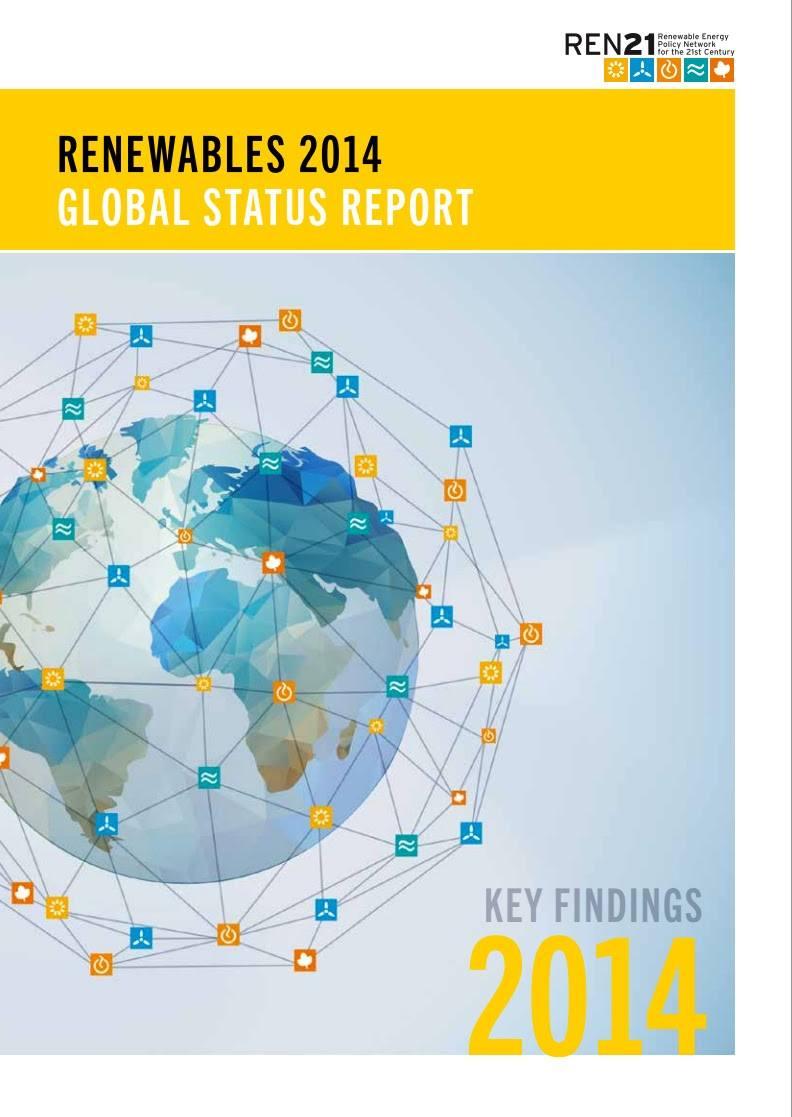
Renewable energy sources supplied nearly one-fifth (19 percent) of final energy consumption worldwide in 2012 and continued growing in 2013, according to the Renewable Energy Policy Network for the 21st Century's (REN21) “Renewables 2014 Global Status Report,” one of the most thorough and comprehensive reports on conditions and trends in global use of renewable energy.
Technological advances, cost reductions, and the spread of supportive government policies and institutional frameworks have progressed much faster and further than had been anticipated, REN21 highlights in its latest report, to the point where the cost of wind, solar, biomass, waste-to-energy and geothermal energy is on par, or even below, that of conventional fossil fuels across a widening range of countries, regions and uses. Commenting on renewables' rapid advance into the mainstream energy mix, REN21 states:
“[M]ost mainstream projections did not predict the extraordinary expansion of renewables that was to unfold in the coming decade. Numerous scenarios projected levels of renewable energy for 2020 that were already surpassed by 2010. Today, renewable energy technologies are seen not only as a tool for improving energy security, but also as a way to mitigate greenhouse gas emissions and to provide direct and indirect social benefits.”
Renewables in 2013: The growing role of developing countries
Geographical expansion and diversification of renewable energy technology and markets across the developing world was a key driver of growing renewable energy use in 2012 and 2013, according to REN21's latest annual report, its sixth. Renewable energy is growing across key large, developing countries – such as Brazil, China, India and South Africa -- as well as regionally across the Asia-Pacific; Europe; the Middle East and Africa; and the Americas.
As REN21's 2014 report authors bring to the fore:
“The number of emerging economy nations with policies in place to support the expansion of renewable energy has surged more than six-fold in just eight years, from 15 developing countries in 2005 to 95 early this year. Those 95 developing countries make up the vast majority of the 144 countries with renewable energy support in place.”
This is particularly encouraging given that energy demand is growing far faster in developing than developed countries. The lives of billions, as well as increasingly threatened and endangered ecosystems and wildlife, may be saved, if developing countries can forge pathways to sustainable development that rely on clean, renewable energy as opposed to fossil fuel sources.
Among industrially developed nations, the 2009 establishment of solar and renewable energy feed-in tariffs (FiTs) in Japan triggered a boom in clean energy investment that persisted through 2013.
In the U.S., recent initiatives by President Barack Obama to use executive authority to direct the EPA to enact stricter limits on carbon emissions from new and existing power plants. If they can withstand legal challenges by states and vested fossil fuel industry interests, these standards should provide substantial impetus to what's been a rapid pace of renewable energy investment, growth, development and employment.
Strong, growing support for renewable energy among developing countries could serve as another quiver in the arrow of renewable energy proponents in the U.S. and European Union (EU), where vested fossil fuel, power utility and other interests are wielding their tremendous economic leverage to oppose efforts to make a transition to a renewable energy infrastructure and markets.
In a research study undertaken to challenge President Obama and the EPA's imposing limits on power plants' carbon emissions, the U.S. Chamber of Commerce, for example, contends that given energy demand is rising fastest in developing countries, carbon emissions reductions from the proposed limits won't have any significant impact on global carbon emissions. The growing enactment of supportive renewable energy policy frameworks across 95 developing countries, as set out in REN21's latest report, neuters the Chamber's contention.
Also among the highlights of REN21's “Renewables 2014 Global Status Report”:
- Globally, renewable energy growth was most pronounced in the power sector, where global capacity rose 8.3 percent year over year in 2013 to reach 1,560 gigawatts (GW);
- Accounting for around one-third of installed renewable power capacity globally, hydropower capacity increased 4 percent to total some 1,000 GW;
- Collectively, capacity for other forms of renewable energy grew nearly 17 percent to an estimated 560 GW;
- A first, more solar PV capacity was installed worldwide in 2013 than wind power capacity;
- Solar power capacity has been growing at an average annual rate of over 54 percent for the past five years;
- More wind power capacity was added over the past five years than any other form of renewable energy.
Overall, renewable power systems accounted for more than 56 percent of net additions to global power capacity and represented far higher shares of capacity added in several countries.
Renewable energy growth: Shifting challenges
REN21's 2014 report also highlights the changing nature of challenges the renewable energy sector faces. Prominent among these are vacillating government policy frameworks; ongoing resistance from entrenched utilities, fossil fuel providers, and automotive and transportation sector manufacturers; and the persistence of “hard” and “soft” subsidies that promote exploration, production and use of fossil fuels. As REN21 notes:
“As renewable energy markets and industries mature, they increasingly face new and different challenges, as well as a wide range of opportunities. In 2013, renewables faced declining policy support and uncertainty in many European countries and the United States.
“Electric grid-related constraints, opposition in some countries from electric utilities concerned about rising competition, and continuing high global subsidies for fossil fuels were also issues. Overall—with some exceptions in Europe and the United States—renewable energy developments were positive in 2013.”Images courtesy of REN21

An experienced, independent journalist, editor and researcher, Andrew has crisscrossed the globe while reporting on sustainability, corporate social responsibility, social and environmental entrepreneurship, renewable energy, energy efficiency and clean technology. He studied geology at CU, Boulder, has an MBA in finance from Pace University, and completed a certificate program in international governance for biodiversity at UN University in Japan.














